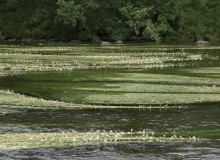
Ranunculus spp
Ranunculus is a large genus of about 600 species of plants. Members of the genus include the buttercups, spearworts, water crowfoots and the lesser celandine. They are mostly herbaceous perennials with bright yellow or white flowers (if white, still with a yellow centre); some are annuals or biennials. There are usually five petals, but sometimes six, numerous, or none, as in R. auricomus. The petals are often highly lustrous, especially in yellow species.
The Water crowfoots (Ranunculus subgenus Batrachium), which grow in still or running water, are sometimes treated in a separate genus Batrachium. They have two different leaf types, thread-like leaves underwater and broader floating leaves. In some species, such as R. aquatilis, a third, intermediate leaf type occurs.
Ranunculus within the Irfon.
The annex 1 habitat created by Ranunculion fluitantis and Callitrcho-Batrachion vegetation is widespread throughout Europe but within the Wye SAC it is in unfavourable condition and declining due to the factors being corrected by ISAC. This project will make a significant difference to this Wye SAC habitat.
Within the Wye catchment there is a varied water-crowfoot Ranunculus flora; stream water-crowfoot R. penicillatus ssp. pseudofluitans is abundant, with other Ranunculus species - including the uncommon river water-crowfoot R. fluitans - found locally.
ISAC
One of the main actions within ISAC is in-channel habitat improvements. In sections of river where the natural geomorphology is severely damaged, recovery will be assisted through a variety of process including hardening of banks with timber, the establishment of natural pool/riffle sequences assisted by the addition of and fixing of coarse woody debris (CWD) and construction of high water refugia.
The re-establishment of naturalised flow and channels is of significant benefit to a range of SAC features. It is acknowledged that this process of naturalisation also restores the appropriate pool, riffle sequence and appropriate flow. The effects of geology and flow are of primary importance and this generally determines which plants can occupy specific locations in the channel (Butcher 1933, Haslam 1978). Flow velocity is thought to be the single most important control on the condition of Ranunculus spp.
Tree management to regulate light penetration is also an acknowledged river management procedure. Bank side and in stream macrophytes, in particular Rannunculas spp, need light and the combination of stock exclusion and increased light penetration following coppicing leads to armouring of banks, better invertebrate diversity and numbers. We anticipate the increase in light as a result of coppicing within ISAC will allow for 1.5ha of ranunculus habitat to establish across the area.
